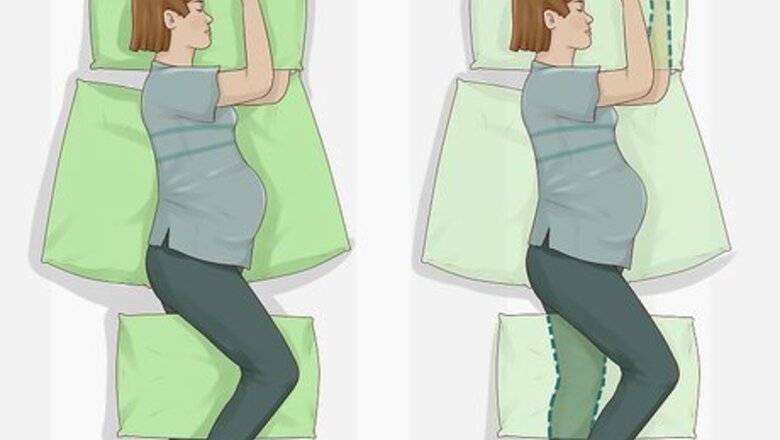
views
X
Trustworthy Source
PubMed Central
Journal archive from the U.S. National Institutes of Health
Go to source
Of course, you’ll need to take some special precautions to help keep your wife and baby safe, like having your wife lie on her side, using long, gentle strokes rather than deep-tissue massage, and avoiding massages during the first trimester.
- Massage your wife’s shoulders and neck, back, scalp, and legs to relieve soreness and discomfort.
- Clear massages with your wife’s doctor first, and avoid doing them in the first trimester. Don’t massage her belly directly.
- Use long, smooth strokes, keeping your hands flat as you work. Massage your wife without essential oils, and stop if she feels discomfort.
Massaging Different Areas
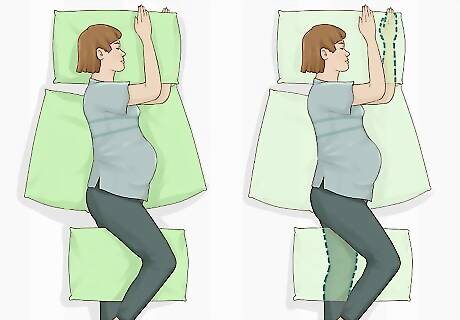
Have your wife lie on her side supported by pillows. The safest and most comfortable position for a massage is for your wife to lie on her side with pillows below her head and belly for support. That will help prevent strain on her uterine ligaments. You can also place a pillow between her knees to help cushion her legs and hips, and she may be more comfortable if her knees are bent and slightly drawn up toward her chest. Allow your wife to determine her comfort level, and help her make any adjustments to the pillows or her position if she needs them. Your wife shouldn’t lie on her back, especially after her fourth month of pregnancy. This can create pressure on major blood vessels that can lower your wife’s blood pressure and cause decreased blood supply to the baby. A semi-reclining position can also be effective for massage. For instance, you may place a pillow against your belly, then have your wife lean into you so her back is against the pillow. She can also rest her head against your chest, especially if you're just massaging her neck and scalp. However, if you're massaging her shoulders and back, she'll probably need to lean forward slightly. Your wife might also try kneeling on the floor facing the bed. She can then rest her arms on the bed to support herself, if that's comfortable for her.
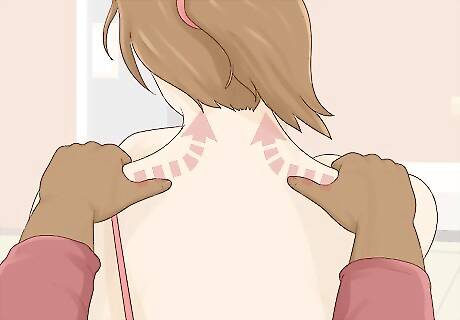
Massage your wife’s shoulders and neck to relieve stress-related tension. Cup your hand around one of your wife’s shoulders where it meets her neck, then slide your hand up to the base of her skull. Slide your hand back down to the outside of her shoulder. Use the base of your hand or the pads of your fingers to gently apply pressure anywhere the muscles feel tight. When you’re finished, repeat on the other side. This is a good massage to do when your wife is sitting down. You can also run your hands up and down the outside of her arms as you do this. Try walking your thumbs up and down her neck on either side of her spine, especially near the base of her skull and where her neck and shoulders meet. EXPERT TIP Will Fuller Will Fuller Certified Massage Therapist Will Fuller is a Certified Massage Therapist and Wellness Educator working in San Francisco, California. Will has worked with the Sports and Recreation Center at the University of California, San Francisco (UCSF), taught sports in England, Kenya, and Kuwait, and is now affiliated with the Chiro-Medical Group. He was trained in physical rehabilitation under a program founded by Dr. Meir Schneider. He has a Bachelors in Sport Science and a Post-Graduate Certificate of Education in Physical Education from Southampton University. Will Fuller Will Fuller Certified Massage Therapist When you're giving a massage, your goal should be to stop the tension from returning, even more than simply getting rid of it. A massage therapist can help you learn how to use soft tissue mobilization, foam rolling, stretching, and self massage to stop those tension patterns from returning.

Rub and knead your wife’s back to ease her sore muscles. While your wife is lying on her side, rub your palms along her back on either side of her spine. Pay attention to any areas that feel especially tight, then gently knead those areas with the base of your hands or your thumbs, working up and down her back. You can also gently press in with your fists along her lower back. As your wife’s belly grows, it will create a lot of new pressure which can lead to back pain, especially at the end of a long day. Avoid massaging along her sides, as pressure in those areas can tickle or hurt.
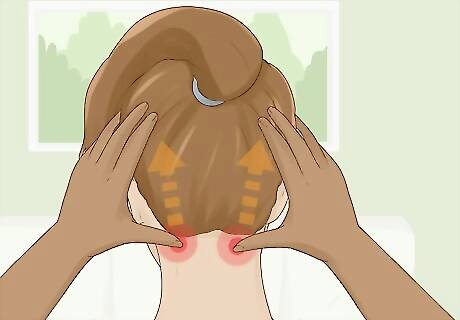
Help your wife relax with a loving scalp massage. Cup both hands around her head, just behind her ears. Gently move your hands in a circular motion, either in the same direction or in opposite directions. Work your hands up toward her hairline and down toward her neck. You can also use your fingertips to apply gentle pressure to her scalp. Pregnant women may be more at risk of migraines, and scalp massages can alleviate headaches. When the rest of your wife’s body is feeling bulky and uncomfortable, a scalp massage can be a surprisingly soothing experience, and it can be a great way for you to be affectionate with her.
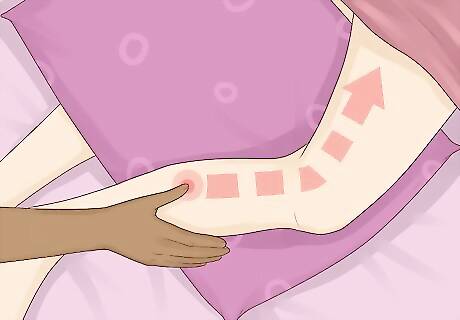
Rub your wife’s legs and feet to help relieve pain and swelling. A pregnant woman’s legs and feet can often get sore and swollen, especially late in pregnancy, and a gentle massage can help alleviate her discomfort. Use your flat palm to massage up and down her legs, and rub the top and bottom of her foot with your whole hand, all the way up to her ankles. Then, use your thumbs to make gentle circles near her heels and the balls of her feet. You can also gently pull on each of her toes, or you can rub between her toes with your fingers. Note that her big, second, and baby toes and her ankles contain pressure points that may stimulate contractions or induce preeclampsia if she has blood clots, varicose veins, or deep vein thrombosis, so be careful applying too much pressure to these areas.
Following Safety Precautions

Be careful massaging your wife during her first trimester. The first trimester is a delicate time when the risk of miscarriage is highest, and a massage can put a strain on the uterine ligaments. You may still massage your wife in the first trimester, but it’s safer to wait until the start of the second trimester, or her thirteenth week of pregnancy, just to be sure. In addition, a massage may make your wife feel dizzy and ill, especially if she’s struggling with morning sickness. Many professional massage therapists will not offer prenatal massages during the first trimester due to the increased risk involved.
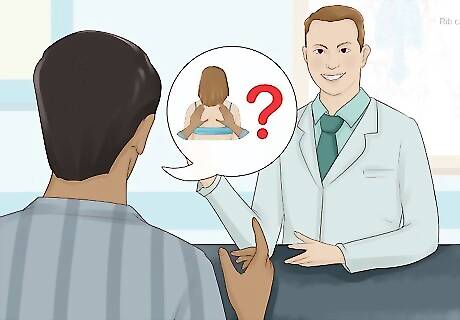
Ask your wife's doctor if a massage is okay if she has any medical conditions. Even after you enter the second trimester, it’s a good idea to check with your wife’s doctor before you give her a massage. This is especially important if your wife has any conditions that might complicate her pregnancy, such as diabetes, high blood pressure, abdominal pain, or bleeding. Your doctor can tell you whether it will be safe to proceed. Other conditions where massage might not be a good idea might include if your wife has a fever, virus, or severe morning sickness.
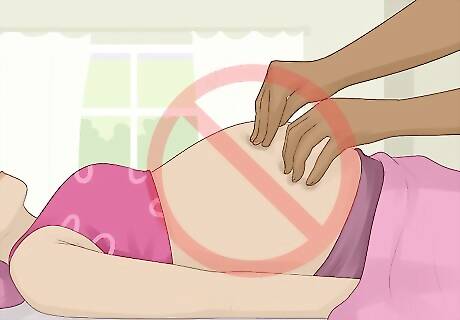
Do not massage directly on your wife’s abdomen. In addition to being uncomfortable for your wife and baby, an abdominal massage could lead to placental or uterine rupture. This can lead to pregnancy complications that could include miscarriage and endanger your wife's life, so it’s better to avoid it entirely. Of course, it’s perfectly fine to rub your wife’s belly. Just keep your hands flat and use very light pressure. This can be a great way to feel your baby moving around, especially after week 24!
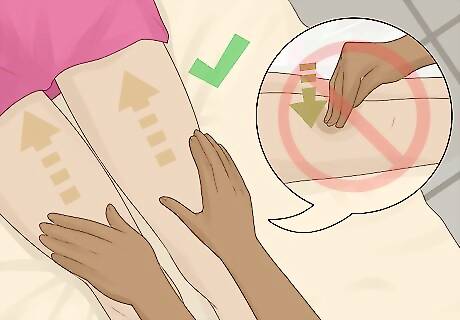
Use long strokes rather than deep pressure. Deep tissue massage can be too intense and uncomfortable during pregnancy, so try to keep your hands flat and your motions smooth and firm. In addition, a strenuous massage may dislodge a blood clot, which pregnant women are especially at risk for. For instance, instead of squeezing your wife’s legs, where blood clots are especially a concern, you could run the heel of your hand up and down her leg muscles. Throughout the massage, ask your wife if there are any areas where she’d like you to apply a little more pressure or go a little easier.
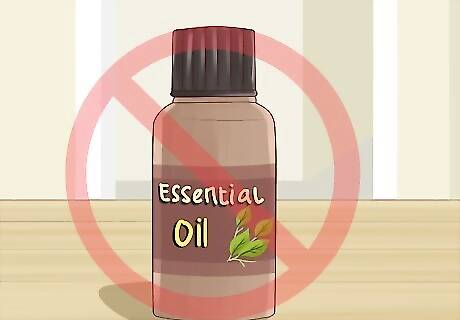
Do not use essential oils during your massage. Some essential oils, like lavender, are believed to be safe for use during pregnancy. However, the effects of essential oils on a developing baby aren’t fully understood, so it’s best to avoid them altogether or speak to your doctor before using them. Try using an unscented massage oil or lotion to help decrease friction during a massage.
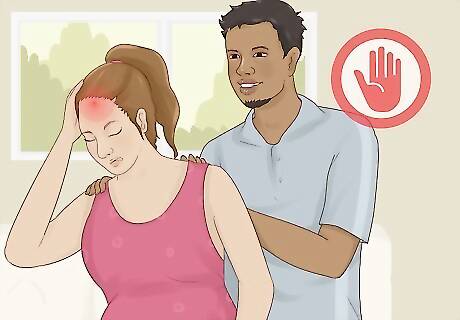
Stop the massage if your wife complains of dizziness, discomfort, or contractions. Massage can have a wide range of effects on the body, including increased blood circulation and the release of endorphins. These can lead to unpredictable reactions, especially in a pregnant woman whose body is constantly changing. Additionally, lying on her back or side for an extended period of time could leave her feeling dizzy or nauseous. If your wife becomes uncomfortable, or if she suddenly has contractions, stop the massage and take steps to help her feel more comfortable. For instance, you could help her sit up and rest against a pillow, then you might get her a glass of water while she relaxes. If your wife's condition doesn't improve within an hour, or if her contractions increase, call her primary care provider and ask them for advice. They may advise you to bring her to their office or take her to the hospital as a precaution.
















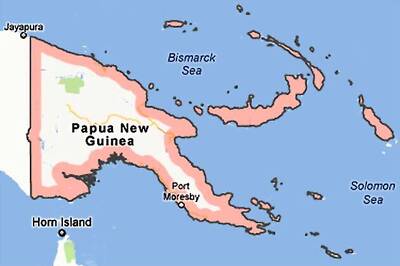



Comments
0 comment